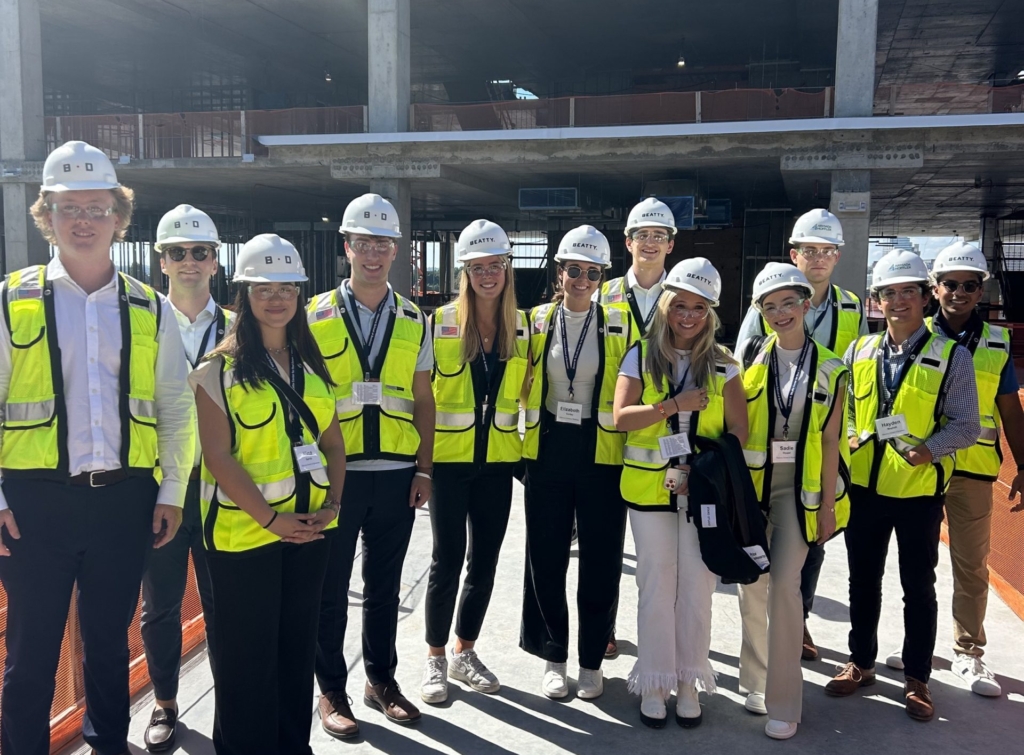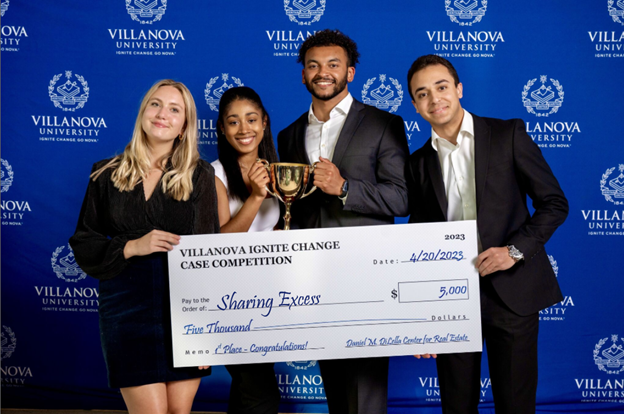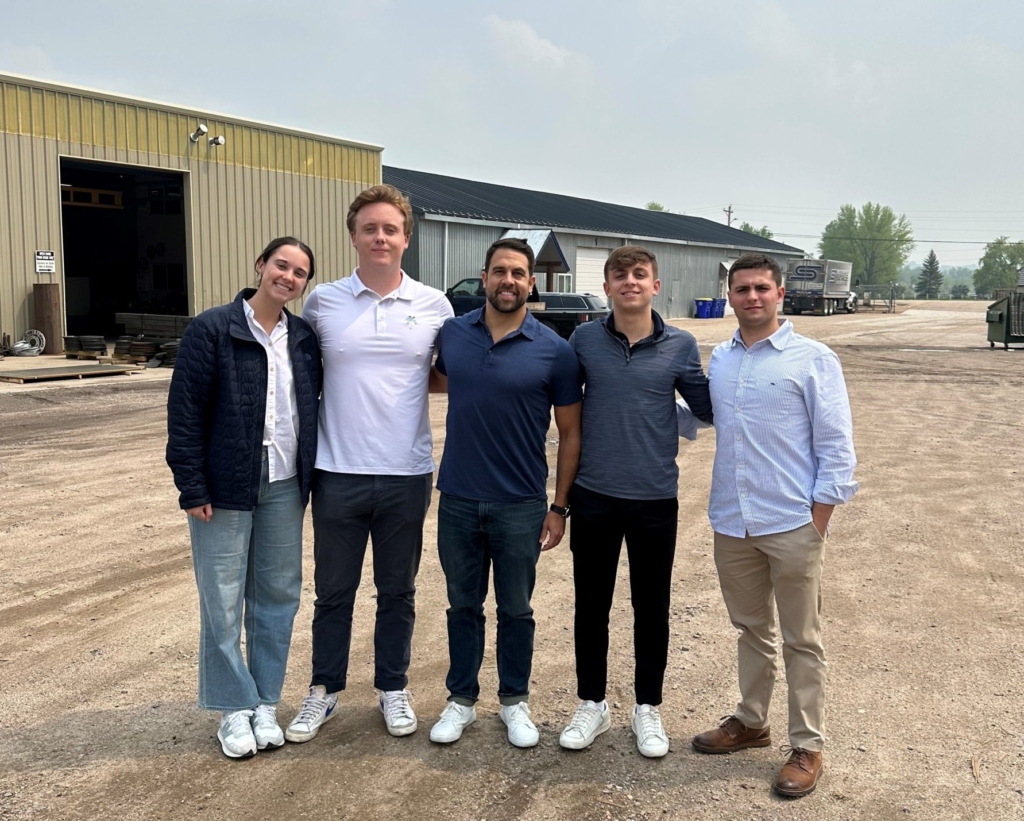
Villanova School of Business students on a trip through the Daniel M. DiLella Center for Real Estate. Courtesy photo
Daniel Magrini is a fund manager at a commercial real estate investment fund with a portfolio of 10 different properties around the country and a gross asset value of just over a million dollars. Last year, he closed a deal on an industrial storage facility in Loveland, Colorado.
But he’s not yet a college graduate. Magrini, a senior in the Villanova School of Business at Villanova University, has been a member of the school’s student-led real estate investment fund for two years.
While there are several student-led investment funds at the graduate level, Villanova’s Daniel M. DiLella and Thomas M. Mulroy Real Estate Student Managed Fund is the first-ever such real estate fund managed by undergraduate students.

Daniel Magrini, VSB ’24
“Learning in the classroom is important but when you sit down and look at a live deal and see the intricacies of the real world, you quickly realize how little you know. Without the fund, I wouldn’t be anywhere near where I am today,” says Magrini who is majoring in real estate with a minor in computer science. He joined the fund as a junior with the hopes of getting real-world experience.
“The experience gained is priceless,” says Magrini who aspires to someday own his own real estate company.
“The fund is obviously great for resumes and interviews, but the true value lies in the knowledge gained and the control that you have as a student. I can say that as a junior in college, at the age of 21, I closed my first real estate deal.”
VSB’S DILELLA MULROY FUND
Located in Philadelphia, a quick train ride away from the financial markets in New York City, it makes sense that many graduates of Villanova School of Business start their careers in finance. In fact, in 2022, 32.1% of VSB graduates went to work in the sector – nearly twice as many who went to work in the next highest industries of consulting and accounting.
But it’s building a reputation in real estate as well.
VSB established its first real estate minor about 15 years ago. It added a major about four years later. In 2018, VSB and the Daniel M. DiLella Center for Real Estate launched the student-led DiLella Mulroy Fund for undergrad students to get hands-on experience researching, evaluating and underwriting potential investment opportunities introduced by Villanova alumni and connected real estate firms.
To date, the fund has raised about $500,000 from Villanova alumni investors, most notably from Daniel DiLella and Thomas Mulroy for which the fund is named, says Phil Guida, a 2009 VSB alumni and co-founder and managing principal at Arileus Capital – a private commercial real estate investment firm. Guida has been the VSB Fellow and fund advisor for about two years.
The DiLella Mulroy Fund has invested in 10 projects so far at an average investment of $100,000. Seven are still active, and three properties have since sold, earning an realized internal rate of return (IRR) of 32.4%. That’s about 10% more than you can expect industry wide in the current market, Guida says, and earned a realized equity multiplier of 1.8x.
It’s also placing graduates at some of the biggest players in the real estate game: Blackstone Real Estate Advisors, Brookfield, Equus Capital Partners, Alterra Property Group and others.
“Word is getting out,” Guida says.
Recently the fund crossed another major milestone: Surpassing $1 million in gross asset value – value of cash on hand and market value of its investments.

Villanova School of Business students competing at an Ignite Change Case Competition. Courtesy photo
HOW THE PROCESS WORKS
The fund attracts close to 100 applications a year for about 30 student spots. That’s up from just six students selected in its first year.
“We are structured exactly like a private equity real estate investment firm: You have an acquisitions team, you have an asset management team, you have an investor relations team, and then you have a broader operations department,” Guida says. He acts as the de facto CEO.
First, the fund needs to find potential projects in which to invest. At first, Guida sourced a lot of the properties, largely from Villanova alumni in the industry. But last year, he put more onus on the students to source projects themselves. “It’s such a big part of the role of an acquisitions analyst. And there’s a sales component to it; There’s a kind of an eat what you kill component to that job,” Guida says.
“I would say now, no exaggeration, over half the deals that come across my desk are in some way, shape or form from one of the students. It is really neat to have a junior setting up an email to a principal of a firm, setting up a conference call and talking through an opportunity. They are doing everything that they will be doing for the next five to 10 years of their career, and they’re doing it as 21 year olds.”
Investment opportunities span all types of commercial properties. The fund’s current portfolio has a mix of industrial, multi-family, and retail properties. They range from the Pillars of Grand Rapids – a senior living facility in Minnesota – to the Malvern Technology Center II in Pennsylvania. Even amidst rising interest rates and market volatility, making for a tougher investing environment for commercial real estate, the fund was able to close on the Colorado industrial storage project last year.
Students are now analyzing a deal in their own backyard: A Philadelphia-based project seeking to transform office space into a multifamily residential property. They hope to get a deal in front of the investment committee this semester, Guida says.
“Looking back at the investments we’ve made, they’ve all been very timely with what’s happening in the markets. We made some early multifamily investments when that market was really growing in the late 2000-teens and since then industrial obviously has taken off,” Guida says. “And now, the topic du jour is all of these vacant office buildings, and how much of the stock can we convert to multifamily residences?”

Phil Guida, center, poses with students from the DiLella Mulroy Fund during a site visit to an investment property in Loveland, Colo. Courtesy photo
THE ART OF THE DEAL
Once a deal has been sourced and analyzed, it must be presented to the fund’s investment committee composed of senior VSB alumni and local Philadelphia commercial real estate leaders.
Students create 50-page pitch books and prepare for weeks to be able to answer the committee’s probing questions. You might expect the committee would go a little lighter on the students, giving grace to their age and relative inexperience. You’d be wrong.
“Oh my gosh, it’s what you would see in the real world. They’re asking the hardest questions that you can imagine because, at the end of the day, it’s real life capital that’s being invested into these opportunities,” Guida. “I am blown away by the caliber of the students. When I was in college, 10 to 15 years ago, I don’t remember students being this adept at what they were learning, or being so passionate about it. It’s really great to see.”

Ricardo Garces Jr, VSB ’24
Office-to-residential projects like the potential Philadelphia property are particularly exciting to VSB senior and fund member Ricardo Garces Jr. With the surge of remote or hybrid workplaces, there’s much uncertainty in office real estate. Out-of-the-box opportunities like the one they are now evaluating could open up even more possibilities.
Garces, who is majoring in finance and real estate, joined the fund his junior year. He first served as VP of Acquisitions, compiling slide decks of market data, sale and lease comps, investment strategy, and more. He presented the Colorado deal to the investment committee and flew out to see the asset in-person. This year, he serves as a senior fund manager.
“Having the opportunity to invest in real assets allows us undergraduate students to learn a lot of the fundamentals and common practices of the industry before having any job experience. It also gets us another step closer to getting our dream real estate investment jobs following graduation,” he says.
Last summer, Garces interned with CBRE Investment Management, working on the core fund portfolio management team.
“The experience and background that I was able to transfer from the Daniel M. DiLella Center for Real Estate Fund to my internship allowed me to grasp topics extremely quickly, whether that was real estate terminology, market comps, or understanding the inner workings of a real estate Fund,” he says.
DON’T MISS: THE UNRIVALED INTERNATIONAL UNDERGRAD EXPERIENCE AT IE UNIVERSITY AND RANKING: THE WORLD’S MOST POPULAR COLLEGES & UNIVERSITIES










